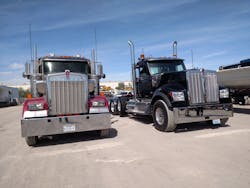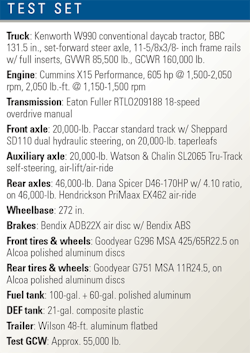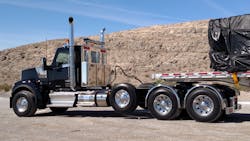It seems like Kenworth’s traditionally styled W900 heavy truck has been around forever. In fact, it was 1961 when the blunt-nose conventional pushed aside the old 900 series with a larger cab, tilt hood, and other advances, and introduced the “W” nomenclature that denotes a set-forward steer axle. Today, after 57 years of steady updates, it’s still offered as the W900B and W900L, the latter with an especially long hood.
Now comes a thoroughly modern but classically styled companion: the W990, touting a wide cab; fresh interior; long, sculpted hood; and a slightly tilted-back but flat-faced grille that identifies the truck as a “W9.” Unveiled last fall with much flash and enthusiasm at the Las Vegas Motor Speedway in Nevada, it immediately struck me as being a worthy replacement for the current model.
But “the W900 isn’t going anywhere,” insisted Kenworth’s general manager, Mike Dozier, in his address to an enthusiastic crowd. It has a loyal following and will be built and sold for as long as enough customers want it. This is the same strategy in force with the venerable T800 vocational model and the more modern T880 that came out in 2013. It now claims about 80 percent of sales that formerly went to the “T8,” but the old model is still being bought and built.
How does the Kenworth W990 compare to the W900?
Viewed separately, there’s no mistaking the W990’s heritage, but it has the 82.7-inch-wide cab currently used on the T880 and T680 road tractor, and the extra 8.7 inches compared to a W900’s cab is noticeable. The new cab is also nearly 6 inches longer, so there’s more room to stretch out and stow stuff behind the seats. With its lengthy hood and wheelbase, this daycab W990 had a regal appearance, especially painted in a “Blackout II” hue. Inside, the Limited Edition trim included black panels and carpet, and black leather seating with blue stitching.
The morning after the unveiling, this daycab tractor and three sleeper-cab versions were gathered for a ride-and-drive experience at Kenworth Sales Co., the Las Vegas-area dealer astride Interstate 15 north of the city. Each was hitched to a different type of trailer; this heavy-haul daycab had a Wilson 48x102 spread-axle flatbed carrying a load of building supplies. Brian Lindgren, KW’s director of research and development who rode shotgun, said the rig was relatively light at about 55,000 pounds gross, so the 605-horsepower Cummins X15 Performance diesel under the long hood mostly loafed. It chugged under acceleration and steadily throbbed while cruising—music to most drivers’ ears. With a 4.10 axle ratio, engine rpm in top gear were several hundred revs higher than for a freight-hauling tractor with longer-legged gearing.
The transmission was a Fuller 18-speed manual that, in spite of the growing popularity of automated gearboxes, is still preferred by heavy haul operators, Lindgren said. This tractor also had a reinforced frame and 20,000-pound-capacity steer and pusher axles shod with 425-series tires. That equipment was superfluous with our modest load, but looked appropriate that afternoon when we visited Werdco BC, a Kenworth customer that hauls dirt in double-trailer bottom- and side-dumps, as well as construction equipment; here driver Stephen Burns backed the tractor under a multi-axle, double-gooseneck transporter toting a bulky 130,000-pound Delmag drilling rig. This is the kind of service this tractor was built for, even if it didn’t work that way this day. I’ll bet they’ll have a W990 before long.
Before departing the dealership that morning I had scanned the wide dashboard to familiarize myself with everything. Along with the speedometer and tachometer were 19 electro-mechanical gauges showing conditions of the engine and various components, a decidedly old-school setup that veteran drivers will approve of because they like lots of information delivered by needles on numbers. However, if you want, Kenworth will substitute a large screen for some of those gauges and you can call up gobs of info, much of it in glorious color. The new cab comes wired for the latest electronic diagnostic and safety features, some of which you can’t get on a W900. The new W990 will be an owner-operator’s truck, of course, but KW execs expect it to also be popular with fleets who will use it as a reward truck for their best drivers.
I-15 was the route for most of our cruising, and we made two loops: first up to the speedway exit and back, then up again and through the speedway complex to North Las Vegas Boulevard, which here is a two-lane rural highway. Just to the east is Nellis Air Force Base from where F-15 fighter-bombers blasted off the runway; when both engines’ afterburners cut in, they are really loud, but that noise was muted inside the W990’s well-insulated cab. A few miles up, the highway ascends a modest grade and intersects I-15, then becomes State Highway 91. We used a wide gravel parking area in this interchange’s southwest quadrant to shoot some photos.
The long wheelbase aids weight distribution and makes room for a hefty lift axle that wasn’t needed for our modest test load aboard a Wilson flatbed. The aluminum cab is nearly 9 inches wider and 6 inches longer than the W900’s.
Along the way I observed the half-dozen switches on the steering wheel’s spokes, some for the cruise control and others for audio functions. Many other switches and controls are on the wide single-panel dash in a certain order. Lindgren, whose engineering career has been at Kenworth, explained: “For the 40 years I’ve been at this, I’ve supported the idea that a driver should keep at least the left hand on the wheel and use the right hand to operate things needed while moving, so those things should be to the right, and other switches can be on the left.” That makes sense to me.
The view through the large single-piece windshield was clear and unobstructed. The long hood had a center ridge fronted by the KW badge. The hood slopes slightly downward, as it does on a W9, and the new hood’s horizontal corners roll downward so visibility to the right is better than you might think. KW applies its DayLite doors with sills that dip down toward the A pillars, adding to outward visibility through power-operated glass. And the doors slam shut with a familiar and satisfying thunk. Remotely adjustable side mirrors are large and provide a good look to the rear and along a rig’s sides.
Stand alongside a W990’s hood and you’ll find seams between it and the separately molded fenders—a nod toward the real-world banging and battering a truck can get in everyday service. Instead of tying up the truck for repairs, a mechanic can remove a damaged fender, bolt on a new one, and the vehicle can quickly return to the road. Speaking of parts, Lindgren said this tractor was assembled in the plant at Renton, Washington. The cab and hood came from the plant in Chillicothe, Ohio, and were married at the R&D center to pieces that hadn’t been fully developed when the chassis was built. The guys did a nice job because the vehicle felt solid and tight. Chillicothe is where all W990s will be produced.
It wasn’t long before we had returned to the dealership, and Lindgren and I went out with one of the sleeper-cab tractors hitched to a Wilson livestock trailer. The tractor had a spacious 76-inch mid-roof sleeper, plus a Paccar powertrain: a 485-horsepower MX-13 diesel with a 12-speed automated transmission. The engine was quiet and the tranny smooth-shifting. Call me lazy, but I ended up preferring this setup to the X15 and 18-speed manual. Summing up: The W900 accounts for only about 10 percent of Kenworth’s sales, so it’s noteworthy that the company would make so many improvements to yield the W990. It looked long-and-tall impressive, rode so smoothly that I seldom thought of it, and was a pleasure to drive and be in. It’s like the good ol’ W9, but better.







